What is it Henoch - Schönlein purple?
Henoch-Schönlein purple (HSP) is a form of leukocytoclastic or small boat vasculitis, more frequently observed in children. Sometimes it's called anaphylactoid purple.
HSP results of inflammation of the little ones blood vessels on the skin and other tissues within the body.
HSP generally affects children, but it can also occur in adulthood. The most common symptoms include a vasculitis eruption, joint pain and abdominal pain. It can affect the kidneys and, in some cases, this leads to irreversible kidney damage. However, most cases resolve without treatment or long-term consequences.
Who gets Henoch-Schönlein purple?
The 75% of cases occur in children younger than 10 years. Most researchers believe that it is more common in girls, although some have found that male or both sexes are equally affected. HSP can occur in adults and when it does, it is often more severe and kidney damage is more common than in children. There doesn't seem to be any race predilection. the incidence in the UK it is about 20/100000 children (under 17 years) per year and the incidence of HSP is believed to be similar in New Zealand.
15 to 40% of children have at least one reappearance.
What causes Henoch-Schönlein purpura?
Although the precise cause of HSP is unknown, clinical evidence points to infection. etiology. The maximum incidence of pediatric HSP is during the fall and winter months. Often preceded by an upper respiratory tract infection and it is grouped within families. Beta-hemolytic streptococci are often found in the swab of the throat or there are positive streptococci serology in blood tests.
A multitude of other associations have been reported, including medications. These include ACE inhibitors, angiotensin II receiver antagonists, clarithromycin and nonsteroidal anti-inflammatory drugs.
The underlying mechanism of small blood vessel inflammation is the statement from IgA immunoglobulin within the walls of the blood vessels. This leads to leukocytoclastic vasculitis. A subtle IgA defect can predispose people to develop HSP.
What are the clinical characteristics of Henoch-Schönlein purpura?
Henoch Schönlein Purple
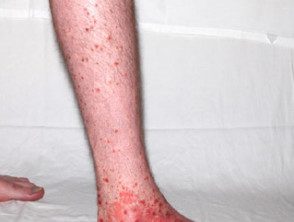
Classic purple
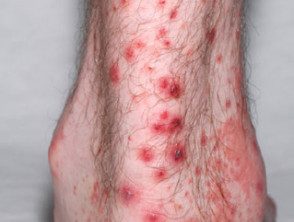
Swelling of the ankle (arthritis)
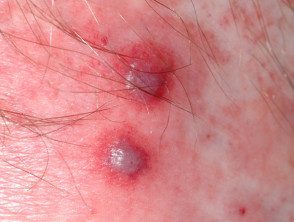
Close-up of the purpuric eruption with the formation of vesicles (blisters)
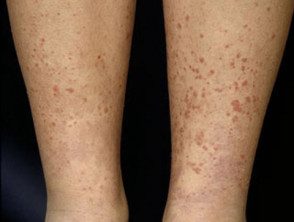
Henoch Schönlein Purple
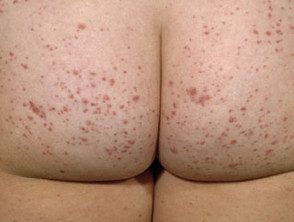
Henoch Schönlein Purple
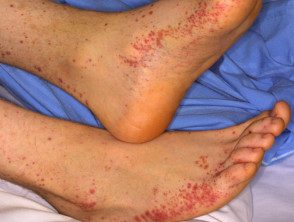
Henoch Schönlein Purple
The classic presentation of HSP is with a tetrad of symptoms and signs:
- eruption
- arthritis
- abdominal pain
- renal insufficiency
Symptoms are generally preceded by 2 to 3 weeks of fever, headache, muscle / joint pain or abdominal pain.
A rash is present in practically all cases. It usually starts as red spots or bumps (which may have a “hive” appearance) that quickly change to small dark purple bumps (palpable purple) within the first 24 hours. The most common sites of involvement are the lower legs, buttocks, elbows, and knees. The rash is symmetrical and can even become generalized. Blisters and / or ulcers It can develop in the affected areas.
Arthritis is present in 75% cases and generally involves one to four joints, especially the ankles and knees. It can be transient and move between different joints.
Abdominal pain is present in half or three quarters of patients and precedes the eruption in up to a third. Abdominal pain may be associated with diarrhea and intestinal bleeding. Orchitis and intestinal invagination are possible complications.
Renal involvement is seen in up to 50% of cases. It is usually mild and self-limiting, however it is important that it is diagnosed and followed up as persistent deterioration may occur. It usually occurs within a few days to a month after the onset of the other symptoms. Approximately 10% has severe kidney problems at presentation, 15% is left with subtle abnormalities in its urine tests, and 1-5% progresses to long-term end-stage renal failure.
Rarely are other organs, such as the lungs, brain, and heart, involved.
What tests should be performed in Henoch-Schönlein purpura?
The diagnosis of HSP is often obvious if classic symptoms are present.
- A blood and urine test should be done to detect any signs of kidney involvement. These tests should be repeated initially at regular intervals to ensure that kidney failure does not develop or worsen.
- Blood pressure must be measured at the same time.
- A skin biopsy Often not necessary, especially in children, but can be done to confirm the diagnosis.
What is the treatment for Henoch-Schönlein purpura?
In most cases, no specific treatment for HSP is required and the rash goes away within a week. Recurrent Injury cultures occur over the next 6–16 weeks in up to a third of cases. Five to ten percent can have a persistent disease.
- Non-steroidal-antiinflammatoryMedications (eg ibuprofen) are effective in relieving joint and abdominal pain.
- In more severe cases, oral steroids are often used.
- Other options include dapsone or colchicine.
- If there is significant kidney involvement, steroids are generally combined with more potent immunosuppressive drugs or intravenous immunoglobulin.

